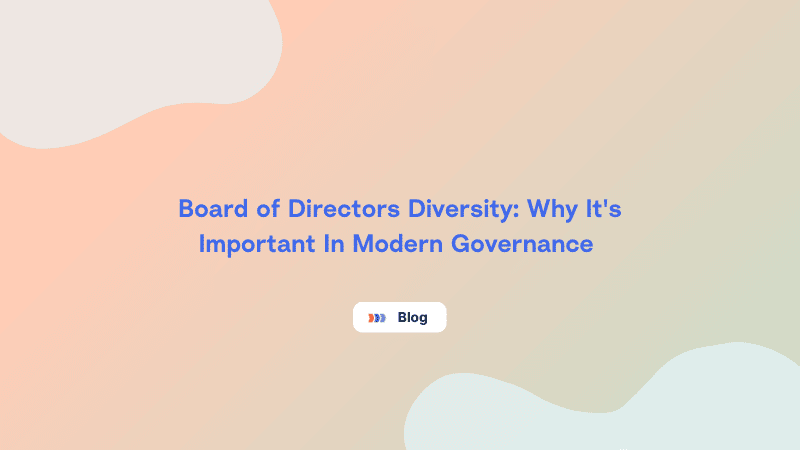Board Of Directors Diversity
Diversity in the business and nonprofit sector should be more than just a buzzword. It’s important that people of all backgrounds and identities are invited to and have a seat at the table. Diversity means a lot of things – it’s not about just any one demographic factor. Diversity is about inclusion, about making sure that people of all genders, disabilities, races, colors, religions, sexual orientations, creeds, or any other criterion find themselves represented amongst your board.
Diversity in 2022 is about intentionally including those who have found themselves left out in the past. This is not due to any faults of their own, or being found less worthy, but about the differences in access that made it much more difficult to reach the top. Not to mention that the financial investors and much of the public at large are demanding more diversity in boards and leadership. 2022 is the year that the field begins to level in terms of leadership diversity. At least, more institutions and organizations are beginning to take a stand toward prioritizing and taking note of the benefits of board diversity.
Here are a few businesses that have highlighted the importance of having a diverse board of directors:
Merch
- The former CEO of Merck, Ken Frazier, was one of America’s very few African American CEOs in Fortune 500 companies. The company’s board in 2021 was relatively diverse with 21% African American directors and 42% women. Frazier noted that “taking the time to recognize and address challenges from a systems level is a crucial first step for any leader interested in boosting their board of directors diversity.”
Best Buy
- In 2012, there was only one woman on Best Buy’s board of directors. It took a new CEO, focused on inclusion, to increase that number to five women and four people of color on a board with eleven seats. Best Buy’s CEO is currently Corie Barry, who stated that it was time to “hold [them]selves accountable for this work [they’ve] promised to do” in regards to diversifying their organization.
HP
- The board of directors at HP is one of the most diverse in the entire tech industry, with 58% minorities and 42% women. HP’s CEO Enrique Lorez published a LinkedIn article stating that “building a more diverse board is just a start. Business leaders need to closely examine all aspects of their organizations—from the C-Suite to the frontline, to the partners they are collaborating with, and the supply chains they depend on—to make sure their companies and operations reflect the markets and communities they serve.”
Starbucks
- In 2017, Starbucks became one of the top companies with a diverse board of directors in the country. In the years since then, they have followed on developing their board to more closely reflect the people they serve as one of the most successful coffee chains in the world. In September of 2020, their board was 46% people of color and 39% female.
Dr. Jason Wingard, commenting on the above boards and diversity on boards in the U.S. as a whole, stated that “…diverse board rooms — do not magically appear. Creating a balanced board of directors requires intention and accountability. It requires time and commitment. It requires transparency and hard work. It requires investment, both literally and figuratively, from those at the very top. And, above all, it requires the abandonment of tired excuses.”
What Is Board Diversity In Corporate Governance?
The importance of board diversity has been evident for some time, but it is only now beginning to trend towards improvement. Many who have never had to wonder “What is board diversity in corporate governance?” may be unsure as to where to start when looking to diversify their own boards. Although there is much to discuss when diversity is concerned, the simple matter of diversity in corporate governance is the cultivation of a broad spectrum of demographic characteristics and identities within the boardroom.
Board diversity and firm performance may be linked, with many industry professionals agreeing that diversity is the way of the future and should be embraced. While that may be true, there are both advantages and disadvantages of board diversity. Although the disadvantages may be better described as a “side-effect” due to the fact that they are not purely negative results.
Advantages
- Board diversity creates more effective decision-making.
- Diversity amongst a board protects against a herd mentality and fosters more free thought and spirited discussion. A truly diverse board may not always agree on the best course of action – that respectful conflict fosters discussion and problem-solving, possibly resulting in a stronger, more holistic solution than what would have occurred in an echo chamber.
- Diverse leadership in boards creates a larger network of support and better utilization of resources.
- This is important in talent recruitment and development, building business relationships, and selling products. When the requirements for board leadership are re-examined, there may be more qualified and better-suited candidates who previously were not able to be discovered due to systemic factors at play.
- Diversity can provide key customer insights and improve brand loyalty.
- Minorities make up nearly 40% of the United States population, and yet they are not proportionally represented in board leadership at all. Businesses and nonprofits with diverse boards appeal to more diverse populations and are better able to map customer experiences, enabling increased sales overall.
Challenges
While the benefits of board diversity are many, creating an inclusive board is not without its challenges. A few of the hurdles to creating and keeping a diverse board might be:
- The backlash from those opposed to diversity overall.
- While this is one of those that can’t be called purely a “disadvantage”, it is a business inconvenience to have your diversity initiatives challenged. For example, it was recently reported that legal action has begun against Starbucks for its inclusion policies. While individuals who resent and repress diversity are typically enemies of progress and inclusion overall, boards that are seeking to diversify intentionally may face a similar challenge.
- Potential increased friction amongst board members
- As previously mentioned in the advantages column, a diverse board may not always agree due to differences in their backgrounds and circumstances. While challenging in the beginning, conflict in the boardroom should result in a stronger, healthier solution that serves more people as a whole.
What is the Importance Of Diversity?
When asking, “What is board diversity?” there is much to consider. While gender diversity on the board of directors is growing, as is racial diversity, there are many elements of intersectionality to be discussed. The importance of diversity in the board of directors is paramount to the advantages and disadvantages of board diversity. While having a diverse and inclusive board is simply the right thing to do, there are also significant benefits that must be taken into account.
For example, companies that are led by female CEOs are less likely to face discrimination and harassment lawsuits than those that are led by men. The importance of the board of directors being representative of the communities they serve is especially important in nonprofit organizations, where it can be difficult to gain the trust of the people they most want to impact. Inclusion is for boards of every kind, not just corporate.
It is also important when striving for diversity in boards to invest in your diverse board members and value their contributions. One of the challenges of board diversification is that it can, unfortunately, be misconstrued as “tokenism.” It’s a common claim of those against diversity overall, but can be remedied by thorough and intentional planning to provide equity in the boardroom and in your organization as a whole.
Board Diversity in the Real World
While Merck, HP, Best Buy, and Starbucks are exemplary board diversity examples, they also showcase the advantages and disadvantages of board diversity. They have robust, active boards that seek to advance their organization and are doing it well. However, as we’ve seen in the case with Starbucks, they also face challenges directly tied to diversity and inclusion efforts.
In a way, the pushbacks against inclusion efforts also answer the question – why is board diversity important? The United States is a diverse country, and in spite of that diversity, most board members are white men. This means that much of the influence and control in our society is held by that demographic. Board diversity means that influence is redistributed amongst a more representative population, possibly changing the tide on how a business is operated or who it chooses to prioritize.
Frequently cited examples of board diversity theory include three different levels – the individual, the board, and the firm. To break it down even further, these three levels are examined under multiple other different theories, although the two most frequently discussed are the resource dependence theory and agency theory. The resource dependence theory proposes that a board of directors serves four purposes to an organization – advisory & counseling that serves to propel the organization, information regarding the organization’s position relative to the socio-economic environment it exists in, and a pathway or network for elevating the organization’s status, and legitimacy as an organization. Individuals seeking to diversify their board within the framework of this theory might argue that by diversifying their board, they now have access to a more diverse pool of resources, amongst other benefits.
The agency theory is one that argues that a more diverse board improves firm performance. Studies of agency theory suggest that an imperfect relationship between organization leaders and their shareholders or consumers exists, and a diverse board can better improve the relationship between those parties whilst ensuring that the interests of all are met.
Alliance For Board Diversity
The need for board diversity and inclusion has existed since the invention of boards, but experts say that those in leadership positions need a push to pursue action. That’s why organizations like the Alliance for Board Diversity and Board Diversity Action Alliance exist – to give those organizations a push. These organizations seek to increase board diversity disclosure to better represent the number of minority members serving in board leadership. Since many organizations have proven to need a push when it comes to diversity and inclusion, some governments have passed mandates regarding diversity in board leadership. Board diversity state laws most notably come from California, in an attempt to increase the gender diversity on boards by mandating that all publicly traded corporations should have at least one woman on their board by 2019 and two or more by 2020.
However, it was struck down and prevented from implementation in 2022. Washington also attempted to pass a similar act, seeking to get more organizations to take advantage of the benefits of female board members. Some lawyers advise that state governments should instead focus on board diversity disclosure laws rather than mandates, which would make board diversity representation reporting mandatory and public. In that case, the public would be able to make a more informed choice about where to work and what companies to support financially.
What about Nonprofit Board Diversity?
Board diversity isn’t only important in the corporate sector, it’s important in nonprofits, too. Nonprofit board diversity is something that seems to be frequently discussed, but like corporate board diversity, is slow to change. Nonprofit board diversity statistics can at times be more difficult to find than those of their corporate cousins – something that disclosure laws may or may not change.
If your organization would like to make a difference in raising awareness about diversity and inclusion in nonprofits, consider having your board fill out a board diversity questionnaire. As stated previously, public disclosure of board diversity can make a difference in the support and success of an organization, which can be a motivator for promoting diversity and inclusion. Additionally, the types of information collected by a questionnaire may remind your board that diversity and inclusion are about more than gender and race.
If your board is really committed to overcoming disparity in diversity, consider forming a diversity and inclusion board committee. This committee could help widen the network of board candidates, increasing diversity on the board, which could compound into more diversity, and bring all the benefits of inclusion along with it. When it comes to diversity and inclusion, nonprofits have the same responsibility to progress that corporate organizations do. In many instances, promoting diversity and inclusion directly relates to the mission of a nonprofit organization.
Boardable is here to partner with you and your organization. Follow along with our resource center where we provide educational materials to set your board up for success.




